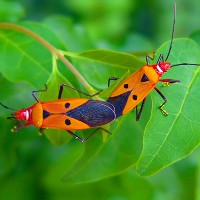Eco-evolutionary dynamics of living systems: Applications
Research by the Evolution and Ecology Program (EEP) is contributing to a growing body of literature stressing the potential of eco-evolutionary dynamics to aggravate the global biodiversity crisis:
- A study of an ongoing invasion of winter moth in northern Fennoscandia [1] showed how eco-evolutionary dynamics can exacerbate risks by inflicting drastic changes on the invaded ecosystem (Figure 1).
- EEP research contributed to a better understanding of invasion processes by synthesizing two leading theories, resulting in a new theoretical framework in which different invasion scenarios can be contrasted and studied [2].
- As anthropogenic activities are remolding the native habitats of species at an accelerating pace, understanding the potential of species to respond to environmental changes is important. Researchers showed that an individual’s ability to adjust its behavior or morphology in response to environmental variations changes nonlinearly with age [3].
- In a related counterintuitive finding, it was demonstrated that mating systems common among animals may detrimentally impact the ability of individuals to change their behavior or morphology in response to environmental variations [4].
- With species ranges being determined by the ability of organisms to adapt and disperse, it is important to understand differences in dispersal strategies. Researchers demonstrated how dispersal strategies change with competition, costs, and the degree of maternal investments [5].
- In a complementary study, it was shown how dispersal strategies can either stabilize or destabilize ecological communities [6].
- In a novel application of eco-evolutionary dynamics to individual development, published by the top-ranking journal Proceedings of the National Academy of Sciences of the USA, EEP research contributed to resolving the long-lasting question why the number of spine bones is so strongly conserved across mammals [7].
- Reliably predicting biodiversity requires understanding the mechanisms that facilitate species coexistence. Drawing on the theory of adaptive dynamics, researchers demonstrated that an often-touted coexistence mechanism is in fact rather unlikely to support coexistence in nature [8].
- In a complementary contribution, researchers demonstrated that the observed coexistence of asexual and sexual reproduction strategies in the Amazon molly (Poecilia formosa) is possible only through mixed reproduction strategies. If the prevalence of asexual reproduction is high, eco-evolutionary dynamics may drive the population to extinction in a process known as evolutionary suicide [9].
- In a study published in the journal Nature Reviews Genetics, current knowledge on how genomic properties influence speciation was reviewed [10].
- The spread of diseases is determined by a complex interplay between the movement of susceptible and infectious individuals. By modeling city commuters, it was shown that intervention strategies for vector-borne diseases should often be focused on nearby villages [11]. In a complementary effort, it was demonstrated how to implement effective intervention strategies prior to actual disease outbreaks in the Tokyo metropolitan commuter network [12].

Figure 1. Eco-evolutionary dynamics can aggravate the risks associated with species invasions, such as the expansion of the winter moth into northern Fennoscandia; © entomart | Wikimedia.
References
[1] Ammunét T, Klemola T & Parvinen K (2014). Consequences of asymmetric competition between resident and invasive defoliators: A novel empirically based modelling approach. Theoretical Population Biology 92:107–117.
[2] Yamamichi M, Yoshida T & Sasaki A (2014). Timing and propagule size of invasion determine its success by a time-varying threshold of demographic regime shift. Ecology 95:2303–2315.
[3] Fischer B, van Doorn GS, Dieckmann U & Taborsky B (2014). The evolution of age-dependent plasticity. American Naturalist 183:108–125.
[4] Nonaka E, Svanbäck R & Brännström Å (2014). Assortative mating can limit the evolution of phenotypic plasticity. Evolutionary Ecology 8:1057–1074.
[5] Fronhofer EA, Poethke HJ & Dieckmann U (2015). Evolution of dispersal distance: Maternal investment leads to bimodal dispersal kernels. Journal of Theoretical Biology 365:270–279.
[6] Sjödin H, Brännström Å, Söderquist M & Englund G (2014). Population-level consequences of heterospecific density-dependent movements in predator–prey systems. Journal of Theoretical Biology 342:93–106.
[7] Galis F, Carrier DR, van Alphen J, van der Mije SD, Van Dooren TJM, Metz JAJ & ten Broek CMA (2014). Fast running restricts evolutionary change of the vertebral column in mammals. Proceedings of the National Academy of Sciences of the USA 111:11401–11406.
[8] Hartig F, Münkenmüller T, Johst K & Dieckmann U (2014). On the sympatric evolution and evolutionary stability of coexistence by relative nonlinearity of competition. PLoS ONE 9:e94454.
[9] Parvinen K (2014). Metapopulation dynamics and the evolution of sperm parasitism. Mathematical Modelling of Natural Phenomena 9:124–137.
[10] Seehausen O, Butlin RK, Keller I, Wagner CE, Boughman JW, Hohenlohe PA, Peichel CL, Saetre GP, Bank C, Brännström Å, Brelsford A, Clarkson CS, Eroukhmanoff F, Feder JL, Fischer MC, Foote AD, Franchini P, Jiggins CD, Jones FC, Lindholm AK, Lucek K, Maan ME, Marques DA, Martin SH, Matthews B, Meier JI, Möst M, Nachman MW, Nonaka E, Rennison DJ, Schwarzer J, Watson ET, Westram AM & Widmer A (2014). Genomics and the origin of species. Nature Reviews Genetics 15:176–192.
[11] Mpolya EA, Yashima K, Ohtsuki H & Sasaki A (2014). Epidemic dynamics of a vector-borne disease on a villages-and-city star network with commuters. Journal of Theoretical Biology 343:120–126.
[12] Yashima K & Sasaki A (2014). Epidemic process over the commute network in a metropolitan area. PLoS ONE 9:e98518.

CONTACT DETAILS
Principal Research Scholar Exploratory Modeling of Human-natural Systems Research Group - Advancing Systems Analysis Program
Principal Research Scholar Systemic Risk and Resilience Research Group - Advancing Systems Analysis Program
Principal Research Scholar Cooperation and Transformative Governance Research Group - Advancing Systems Analysis Program
Research program
Eco-evolutionary Dynamics of Living Systems
Related news


